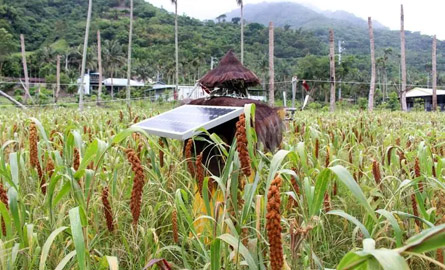For the vast majority of fruit farmers, birds are a loving and hating existence. What I love is that it can help fruit farmers control pests in their orchards, but what I hate is that birds have a great destructive power on fruits (especially fruit farmers who grow cherries and grapes). Although a bird cannot eat much (there are not many small areas planted), the data becomes very scary when multiplied by the number of birds. Moreover, birds usually peck a few times and peck twice for food, causing great waste. The fruits that are pecked are also susceptible to secondary damage caused by pests and diseases.
On the one hand, birds damage and damage fruits, and on the other hand, most birds are also important natural enemies of pests in orchards and farmland. In a study, it was found that birds can eat up to 98% of the apple moth larvae. Therefore, while preventing bird damage, attention should also be paid to protecting these birds. It is recommended that orchards in various regions adopt one or more of the following bird repellent methods according to their own conditions and local conditions.

1. Fruit bagging
Bagging fruit ears is the simplest way to prevent bird damage, while also preventing the impact of diseases, pests, pesticides, dust, and other factors on fruit ears. But large billed birds such as gray magpies and crows can often peck through paper bags and peck at fruits. Later, small billed birds such as sparrows add insult to injury, and the fruits that have been pecked are highly susceptible to pests and diseases in the area. Therefore, it is necessary to use paper bags with good quality and strong toughness. Nylon mesh bags can be used for bagging in areas with more birds, which not only prevents bird damage but also does not affect fruit coloring, but the relative cost is relatively high. Simultaneously bagging can only have an effect on grapes, apples, pears, etc., and is not very suitable for cherries, blueberries, etc.
2. Install bird proof nets
Bird proof nets are suitable for both large and small orchards. It is best to use yellow bird proof nets for orchards in mountainous areas, and red bird proof nets for plain areas. These are the two colors that birds in mountainous and plain areas are most afraid of. In areas with frequent hail, adjusting the grid size and combining hail nets with bird nets is a good measure to achieve twice the result with half the effort. However, the cost of bird proof nets is high, and their lifespan is short. After fruit harvesting every year, they must be collected, which is quite labor-intensive. Moreover, they are prone to aging and cracking due to external scorching sun and strong winds. Especially at the beginning of this year, the bird proof nets in some vineyards in Jiangsu and other areas were damaged due to the collapse of heavy snow, resulting in significant losses.
3. Add isolation nets
For some fruits such as raisins, appropriate specifications of wire mesh and nylon mesh should be set up in advance on the air inlet and outlet of the drying room, as well as the air vents and air vents, to prevent birds from entering.
4. Improving Cultivation Methods
In areas where bird damage is common, retaining more leaves, covering fruit ears, and paying attention to the hygiene around the orchard can also significantly reduce the occurrence of bird damage.
5. Use a bird repellent
In recent years, more and more fruit farmers have begun to use intelligent voice bird repellents to drive birds. This system uses low-power microcontrollers as the core and the latest digital voice storage technology to collect and form a sound chip library for different birds. High performance controllers are used to play high fidelity bird predators' sounds in random order, frequency, and other ways.
The experiment has proven that the intelligent voice bird repellent system is sustainable and effective in achieving wide-area bird repellent in orchards, farmland, and fish ponds. It has been successfully applied to crops such as cherries, goji berries, grapes, pears, apples, bayberries, and millet, and has a good repellent effect on various harmful birds in orchards, receiving unanimous praise from fruit farmers.









